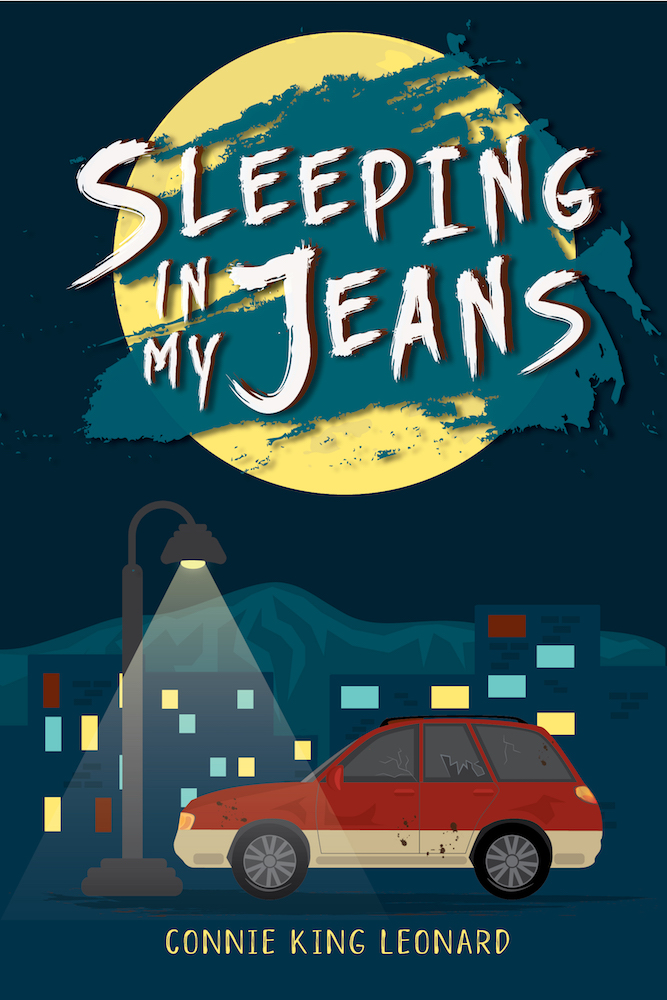Connie King Leonard is the author of Sleeping in My Jeans, a YA novel about a teen girl who has to live out of her car with her mother and young sister. I had the pleasure of sitting down with Connie to discuss what inspired her to write a book about being homeless, what message she hopes it will send, and the unique protagonist at the center of it all—Mattie Rollins.
How did you find Ooligan Press?
I saw an announcement in a Willamette Writers newsletter from Ooligan Press and went to the website. Ooligan was looking for work set in the Northwest dealing with a marginalized population, and I felt Sleeping in My Jeans fit that criteria. I checked with writer friends and found Ooligan had a good reputation as a reputable publishing press.
Your novel is fiction, but it rings true. Do you think it represents real stories of women and girls on the streets?
I do. Women and children are sometimes victims of domestic violence, which puts them in a vulnerable position—particularly if they don’t have the resources to afford to live on their own.
But abuse isn’t the only reason women end up in the street. The loss of a job, a major medical expense, and countless other catastrophes can destroy their ability to meet basic housing expenses. Even families with two adults working full time find themselves with financial problems.
What inspired you to write Sleeping in My Jeans?
I set the story in Eugene because I could visualize Rita parking Ruby in different areas of town, and I thought the best place she could leave Mattie and Meg after school was the city library.
The story was inspired by a sixth grade student I had in science class. Teaching kids to come prepared for class was one of our school goals. That meant bringing your binder, book, and pencil. I checked every day to make sure my students had what they needed.
One boy, I’ll call him Johnny, was a good kid and worked hard in my class, but mid-year he quit bringing his science book. I’d remind him and he would nod that he understood. One day, I said, “Johnny, I want you to go home tonight and look through your room for that science book.”
Johnny whipped his head around and said, “There are five of us living in a camper on the back of a pick-up. My science book is not there.”
Students in middle and high school do not always share the hardships and problems in their lives like elementary students. Even when teachers ask kids if they are okay or need help, older kids don’t open up like little ones. Johnny’s outburst was a shock. I was sick, disgusted with myself for not being in tune with my students.
I got Johnny another science book, but I have never forgotten him, because he taught me a huge lesson. The farm where I grew up in North Dakota was small and poor, but I always had a roof over my head and food on the table. I was privileged.
Why did you choose to write Mattie as biracial?
I am glad to see more wonderful stories being published about kids of color, which is great, but I still don’t see many about biracial kids. From my first idea for this novel, I pictured Mattie as strong, brave, and biracial and couldn’t think of her any other way.
What do you hope your book will achieve?
I want kids to know they are not alone in their struggles, whatever those hardships may be. In Mattie’s case, she has a small and beautiful family, but she lives in extreme hardship. Other kids problems are different, yet sometimes they feel like they are the only kid in school that doesn’t have a perfect life. Mattie is strong and resilient, and I hope kids learn from her determination to strive for a better life.
I also want people to be aware of the lack of affordable housing and know that not everyone goes home to a warm house or even a small apartment. Some of the students in their school may be living in a car, camped in a tent, couchsurfing between family and friends, or living in a shelter.
I hope my readers will enjoy Sleeping in My Jeans and will care about Mattie and her family as much as I do.
Do you have any suggestions for how to get involved with aiding homeless and domestic abuse survivors?
My biggest suggestion is to be aware that the person sleeping in a doorway is a human being. He/she may have serious issues that you and I can not help with, but that person deserves our compassion.
Many people now use the term “houseless” instead of “homeless”, because the new term recognizes that the tent on the side of the freeway or the beat-up minivan parked on a back street is someone’s home. I am training myself to switch terminology.
Lastly and maybe most importantly, we need to fund affordable housing as well as shelters for victims of domestic violence, teen runaways, families in need, veterans, and people with addictions and mental illness. It is a huge task, but one that is being tackled by some great organizations. St. Vincent de Paul in Eugene is doing an amazing job of providing housing options for people in all sorts of circumstances. Food for Lane County and the Oregon Food Bank are two other organizations that provide immense help to so many people in our state.
A portion of the sales of Sleeping in My Jeans will be donated to St. Vincent de Paul for the building of a youth house for houseless teens.

